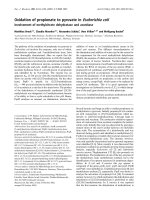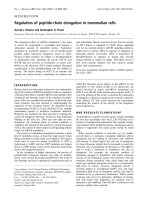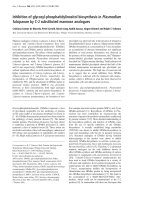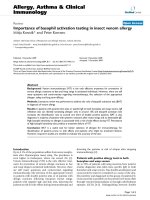Báo cáo y học: "Lethality of suicidal organophosphorus poisoning in an Indian population: exploring preventability" potx
Bạn đang xem bản rút gọn của tài liệu. Xem và tải ngay bản đầy đủ của tài liệu tại đây (209.32 KB, 5 trang )
BioMed Central
Page 1 of 5
(page number not for citation purposes)
Annals of General Psychiatry
Open Access
Primary research
Lethality of suicidal organophosphorus poisoning in an Indian
population: exploring preventability
Nilamadhab Kar*
Address: Wolverhampton City Primary Care Trust, Corner House Resource Centre, 300 Dunstall Road, Wolverhampton, WV6 0NZ, UK
Email: Nilamadhab Kar* -
* Corresponding author
Abstract
Background: Suicide by organophosphorus poisoning is common in India. Study of factors
associated with lethality may suggest methods for prevention.
Methods: Severity of symptoms, biochemical manifestation of poisoning, degree of lethality and
the outcome were studied with an aim to explore the modifiable factors associated with lethality
and to discuss preventability. Clinical variables were collected; symptoms were rated by the
physicians using global impression of severity; and the lethality was assessed by scale for assessment
of lethality of suicide attempt (SALSA), in 100 consecutive patients with suicidal organophosphorus
poisoning attending a medical college hospital in South India.
Results: Fatal outcome (n = 26) was significantly associated with higher mean age, lower mean
pseudocholinesterase level, longer duration between organophosphorus compound ingestion and
specific intervention. All those who died had respiratory failure. Physicians' assessment of symptom
severity and lethality as assessed by the SALSA could differentiate those succumbed and survived
in a significant proportion.
Conclusion: Majority of cases of organophosphorus poisoning were associated with severe
symptoms and higher lethality. Intervention facilities decreasing the period between the ingestion
of poison and initiation of treatment might prevent many deaths. Measures like restricting
availability and banning more toxic organophosphorus compounds may help.
Background
Poisoning is a common method of suicide, especially in
the developing world [1]. In many Indian reports, the
rates of poisoning as suicidal method range from 20.6%
(10.3% organophosphorus) [2] to 56.3% (43.8% organo-
phosphorus) [3,4]. It has remained so for almost a cen-
tury, 44.2% in 1872-76 and 49.2% in 1972 [5]. Reported
poisoning rates in the suicide attempters who attend hos-
pital varies from around 40% to over 80% [6-8] in many
Indian studies. Organophosphorus compounds available
as pesticides are amongst the most common poisons used
[3,9-12]. In hospital based studies mortality rates associ-
ated with pesticides have been reported up to as high as
50–70% [13]. Considerable proportions of children and
adolescent attempters, 50% males and 60% females in
one study [3], have used this method of attempt. Study of
organophosphorus poisoning as a method of suicide
attempt, its presentation in hospitals, lethality and out-
come following intervention may provide insight for pre-
venting death in a proportion of attempters.
Published: 21 November 2006
Annals of General Psychiatry 2006, 5:17 doi:10.1186/1744-859X-5-17
Received: 05 July 2006
Accepted: 21 November 2006
This article is available from: />© 2006 Kar; licensee BioMed Central Ltd.
This is an Open Access article distributed under the terms of the Creative Commons Attribution License ( />),
which permits unrestricted use, distribution, and reproduction in any medium, provided the original work is properly cited.
Annals of General Psychiatry 2006, 5:17 />Page 2 of 5
(page number not for citation purposes)
Specific aim of this study was to evaluate suicide attempt
by organophosphorus poisoning in an Indian patient
population as they present to a hospital, severity of symp-
toms as observed by the physicians, biochemical manifes-
tation of poisoning, the lethality of the suicide attempt,
and the outcome. It also aimed to discuss the possible pre-
ventive ways based on modifiable factors associated with
lethality.
Methods
In a prospective study, consecutive 100 patients with sui-
cidal organophosphorus poisoning attending a medical
college hospital in South India were evaluated. Patients
with multiple methods of attempt, including multiple
substances for poisoning and accidental poisoning were
excluded. The informed consent was taken from the rela-
tives and later from the patient if he/she survived the
attempt. Age, gender, clinical variables like interval
between ingestion of poison and specific intervention
(pralidoxime (PAM) injection for this index study), respi-
ratory failure, duration of ventilatory support and mortal-
ity were studied. Pseudocholinesterase level was recorded.
Manifestations of poisoning were recorded as mild, mod-
erate or severe by the treating physicians as a global
impression of severity of the symptoms.
Lethality was considered as the possibility or degree to
which any biological change that could have endangered
the life of the patient if not rescued or resuscitated.
Lethality was studied by global impression of lethality
item of the scale for assessment of lethality of suicide
attempt (SALSA) with 5-levels of lethality (degree of
lethality ranged from subliminal to extremely high) [14].
The mode of attempt, rescuability, degree of help
required, maximum severity of physical symptoms mani-
fested and the level of medical intervention required were
considered in deciding about the lethality.
The statistical tests were done by SPSS package. The cate-
gorical data were analyzed by using chi-square tests and
the continuous variables were compared by two-tailed t-
tests. Statistical significance was defined at the standard
0.05 level.
Results
There were 68 males and 32 female attempters (male to
female ratio 2.1:1). Mean age and standard deviation
(SD) of male (31.5 ± 12.37 years) and female (29.7 ±
15.62 years) attempters were not significantly different (t:
0.55, df: 98, p: 0.58). More women (90.6%) in contrast to
men (70.6%) were married (χ
2
: 4.93, df: 1, p: 0.026).
Out of the 100 attempters 26 died. Nineteen males
(27.9%) and 7 females (21.9%) succumbed to their
attempt (ratio: 2.7:1); the difference between the propor-
tions was not statistically significant. There was no signif-
icant difference between the genders regarding the clinical
variables studied.
Comparisons of clinical variables of attempters who died
with those survived their attempt are given in table 1.
Mean age of the attempters who died was significantly
more than that of who survived. Fatal outcome was signif-
icantly associated with lower mean pseudocholinesterase
level which indicated probability of higher toxicity of
ingested substance besides other factors. The duration of
organophosphorus compound ingestion and specific
intervention was significantly more in those died. The
delay was due to many factors including lack of interven-
tion facility locally and the time for travel. All the persons
who died had respiratory failure, compared to 51.4% of
the survived.
Severity of symptoms and degree of lethality of consider-
able proportion of attempts were high. Global impression
of severity of symptoms suggested that amongst those
who died 42.3% had moderate and 57.7% had severe
symptoms of poisoning in contrast to 10.8% mild, 56.8%
moderate and 32.4% severe symptoms of those who sur-
vived (χ
2
: 6.7, df: 2, p < 0.05). Even though 61.5% with
severe symptoms did survive, impression of the physi-
cians regarding severity of symptoms significantly differ-
entiated the outcome. Evaluation of lethality through
SALSA suggested a trend with higher lethality indicator
being associated with higher proportion of death in the
attempters; for example, 75% of the attempters with
extremely high lethality died compared to 38.1% with
high and 21.4% of the moderate lethality (χ
2
: 34.2, df:1,
p < 0.000).
Discussion
The study tried to evaluate lethality in organophosphorus
poisoning and to explore preventability. As reported in
many previous studies males were more represented in
the suicidal patients seen in a hospital setting [15]. A
larger proportion of them compared to females died, but
the difference was statistically not significant. Male/
female ratio in the committers (2.7.1) is wider than the
overall national ratio of 1.4:1 in suicide [1]; suggesting
that in organophosphorus poisoning there is considerable
preponderance of males in hospital setting. It might be
relatively easier for men, some as farmers, to avail pesti-
cides to use as suicide method as observed in other studies
[3]. Concerns regarding increased suicide by farmers in
India are well known [16,17].
Alarmingly 22% of attempters were 20 years old or less
(17% within the age of 18 to 20 years); however all of
them survived. It supports the reports that adolescents are
a major risk group for suicide attempt [18]. Proportions of
Annals of General Psychiatry 2006, 5:17 />Page 3 of 5
(page number not for citation purposes)
attempters who died were more in age groups of 31–40
years and 51 years and above, suggesting probability of
higher risk of suicidal death in these age ranges. Mean age
of those who died was significantly more than that of sur-
vivors.
Mean pseudocholinesterase level was significantly less in
those who died compared to survivors. Though there are
controversies about the correlation between plasma
cholinesterase activity and the severity of organophospho-
rus poisoning [19], it is a marker of the organophospho-
rus intoxication. Number of hours passed between
ingestion of poison and initiation of specific treatment
had significantly influence on the outcome. It was signifi-
cantly more in those who died. Respiratory failure which
was observed in all who died and in 51.4% of survivors
indicated the severity of the attempts and was one of the
significant indicators for outcome.
Lethality is an important clinical variable for both medical
and psychiatric evaluation and management. In contrast
to intent-to-die which is a subjective measure, lethality is
objective, more descriptive of the behaviour, and often
correlate with the degree of intent [20]. In the index study
findings indicated that organophosphorus poisoning in
most attempters was clinically severe with higher degree
of lethality. Physicians' assessment of symptom severity
and lethality as assessed by the SALSA were able to catego-
rize attempts into different grades of severity and lethality
which could differentiate the outcome in a significant pro-
portion.
It is presumable that severity of symptoms and toxicity of
the compounds are related. In the index study most
patients had moderate to severe symptoms, moderate to
extremely high lethality and respiratory failure, besides
significantly lower pseudocholinesterase level in those
succumbed to the poisoning. Though toxicity of ingested
substances was not directly studied; and many factors con-
tribute to severity of poisoning, the above observations
indirectly suggest probability of higher toxicity of ingested
substances in most cases. Banning of extremely toxic pes-
ticides and restriction of their use have been urged by
World Health Organisation [13]. Restriction of availabil-
ity of suicide methods has received some attention as a
possible way of suicide prevention [4,21,22], though it is
also reported that when one method is restricted then the
suicidal methods change [4]. Legislation on drug availa-
Table 1: Clinical variables associated with mortality following suicidal organophosphorus poisoning
Variables n Succumbed (n = 26) Survived (n = 74)
n%n%
Gender
Male 68 19 27.9 49 72.1
Female 32 7 21.9 25 78.1
Age group in years
<18 5 0 0.0 5 100.0
18–20 17 0 0.0 17 100.0
21–30 42 12 28.6 30 71.4
31–40 20 8 40.0 12 60.0
41–50 6 2 33.3 4 66.7
51+ 10 4 40.0 6 60.0
Mean Age (SD)
a
35.88 (13.17) 29.02 (13.2)
Mean pseudocholinesterase level (SD)
b
1448.9 (1120.9) 3165.5 (2715.2)
Respiratory failure
c
64 26 40.6 38 59.4
Mean ventilatory duration in hours (SD) 7.15 (6.01) 5.17 (7.46)
Symptoms of poisoning
d
Mild 8 0 0.0 8 100.0
Moderate 53 11 20.8 42 79.2
Severe 39 15 38.5 24 61.5
Lethality
e
Subliminal 20 0 0.0 20 100.0
Low 15 0 0.0 15 100.0
Moderate 28 6 21.4 22 78.6
High 21 8 38.1 13 61.9
Extremely high 16 12 75.0 4 25.0
Mean PAM interval in hours (SD)
f
7.24 (6.28) 4.37 (4.63)
a
t: 2.28, df: 98, p: 0.024;
b
t: -3.12, df: 98, p: 0.002;
c
χ
2
: 19.76, df: 1, p: 0.00001;
d
χ
2
: 6.71, df: 2, p: 0.034;
e
χ
2
: 34.16, df: 4, p: 0.00000;
f
t: 2.47, df: 98,
p: 0.015; Percentages are from the number of patients in that category of variable; figures in parentheses are SD.
Annals of General Psychiatry 2006, 5:17 />Page 4 of 5
(page number not for citation purposes)
bility and packaging has been effective elsewhere [13,22].
In addition, involving another individual from farmer
community in the sale, use and safe disposal of the
remaining content of organophosphorus compounds
may help. Public education in this regard may be needed.
Efforts to minimize the period between ingestion of poi-
son and initiation of specific treatment may help to
decrease the chance of death in some. Most part of the
duration from ingestion of poisoning to initiation of
treatment was spent travelling/arranging transport to the
hospital. In the developing world many attempters are
referred to secondary and tertiary centres for lack of facil-
ity locally. It is a common observation that many attempt-
ers are brought dead to hospital [8]. Delay in arriving in
hospital with facilities seriously curtails their effective-
ness. Availability of basic facilities for treatment of organ-
ophosphorus poisoning at primary health centres (PHC)
and local hospitals may change this negative outcome for
many, if not for all. Increasing the ability of the primary
care facilities to manage the medical complication of sui-
cide attempt is a recognized intervention in China [21].
Periodic training to the doctors and other health care staff
in community, improving their skills in assessment and
management may help in dealing with more cases in com-
munity effectively in time before the duration of ingestion
and specific intervention gets prolonged. It may help to
have clear protocol and guidelines available for managing
poisoning cases. The facilities for initiating treatment
sooner and respiratory support locally and while transfer-
ring the patient (if needed) may increase the chance of
survival for many attempters. However these suggestions
would require further focused study for their effectiveness.
There are few limitations of the study. The sample was
taken from a tertiary level of health care system. The find-
ings in community sample attending primary or second-
ary centres may be different. Variables which may be
clinically relevant regarding outcome such as existing
other morbidities and treatments were not studied.
Conclusion
In the index study a typical attempter who died was
around 35 years of age, male, with low pseudocholineste-
rase level, respiratory failure, moderate to severe symp-
toms, moderate to extremely high lethality and an average
duration of around seven hours from ingestion to specific
intervention. Assessments of severity and lethality of the
attempts were able to differentiate the attempters from the
committers in most cases. Suicide prevention is a much
broader multi-agency issue; and emphasis is given to pre-
venting the act of attempt itself. However efforts to
decrease the period between the ingestion and initiation
of treatment, restricting availability of organophosphorus
compounds, and banning more toxic ones may prevent
some suicidal deaths following organophosphorus poi-
soning. Organophosphorus poisoning being a very com-
mon method of suicide attempt in developing world
deserves specific attention.
Competing interests
The author(s) declares that they have no competing inter-
ests.
Authors' contributions
NK conceptualized, analyzed and interpreted data, and
wrote the paper.
Acknowledgements
Quality of Life Research and Development Foundation supported the study
in part. Purusottam Mishra, MD, Associate Professor of Medicine, Kasturba
Medical College, Manipal, India helped in data collection.
References
1. Vijayakumar L: Suicide prevention: the urgent need in develop-
ing countries. World Psychiatry 2004, 3(3):158-159.
2. Ponnudurai R, Heyakar J: Suicide in Madras. Indian Journal of Psychi-
atry 1980, 22:203-205.
3. Gururaj G, Isaac MK: Epidemiology of suicide in Bangalore.
NIMHANS Publication No. 43, Bangalore; 2001.
4. Nandi DN, Mukherjee SP, Banerjee G, Ghosh A, Boral GC, Chowd-
hury A, Bose J: Is suicide preventable by restricting the availa-
bility of lethal agents? A rural survey of West Bengal. Indian
Journal of Psychiatry 1979, 21:251-255.
5. Nandi DN, Banerjee G, Boral GC: Suicide in West Bengal – A
century apart. Indian Journal of Psychiatry 1978, 20:155-160.
6. Badrinarayana A: Suicide attempt in Gulbarga. Indian Journal of
Psychiatry 1977, 19(4):69-70.
7. Kar N: Psychosocial aspects of suicide attempt. MD Thesis,
Utkal University, Bhubaneswar 1996.
8. Arun M: A comparative analysis of suicide and parasuicide.
MD thesis, MAHE, Manipal 2002.
9. Chugh SN, Aggarwal N, Dabla S, Chhabra B: Comparative evalua-
tion of "Atropine Alone" and "Atropine with Pralidoxime
(PAM)" in the management of organophosphorus poisoning.
Journal of Indian Academy of Clinical Medicine 2005, 6(1):33-37.
10. Rao CHS, Venkateswarlu V, Surender T, Eddleston M, Buckley NA:
Pesticide poisoning in south India: opportunities for preven-
tion and improved medical management. Tropical Medicine and
International Health 2005, 10(6):581-588.
11. Eddleston M, Szinicz L, Eyer P, Buckley N: Oximes in acute organ-
ophosphorus pesticide poisoning: a systematic review of clin-
ical trials. J Med 2002, 95:275-283.
12. Latha KS, Bhat SM: Suicide attempts among youth: Correlates
of medical lethality. Behavioural Medicine Journal 1999, 2(1):21-29.
13. Wadia RS: Treatment of organophosphate poisoning. Indian J
Crit Care Med 2003,
7:85-87.
14. Kar N: Scale for Assessment of Lethality of Suicide Attempt Quality of Life
Research and Development Foundation, Bhubaneswar; 2002.
15. Arun M, Yoganarasimha K, Palimar V, Kar N, Mohanty M: Parasui-
cide – an approach to the profile of victims. Journal of Indian
Academy of Forensic Medicine 2004, 26(2):58-61.
16. Venugopal D, Jagadisha : An Indian perspective of farmer stress
– a priority area for future research. International Journal of Social
Psychiatry 2000, 46(3):231-235.
17. Sunder M: Suicide in farmers in India. British Journal of Psychiatry
1999, 175:585-586.
18. Kar N, Pany M, Mishra BN, Sengupta J, Das I: Risk factors of ado-
lescent suicide attempt. Journal of Eastern Zonal Branch of Indian
Psychiatric Society 1996, 1(1):17-22.
19. Nouira S, Abroug F, Elatrous S, Boujdaria R, Bouchoucha S: Prognos-
tic value of serum cholinesterase in organophosphate poi-
soning. Chest 1994, 106(6):1811-1814.
20. Hamdi E, Amin Y, Matter T: Clinical correlates of intent in
attempted suicide. Acta Psychiatr Scand 1991, 83:406-411.
Publish with BioMed Central and every
scientist can read your work free of charge
"BioMed Central will be the most significant development for
disseminating the results of biomedical research in our lifetime."
Sir Paul Nurse, Cancer Research UK
Your research papers will be:
available free of charge to the entire biomedical community
peer reviewed and published immediately upon acceptance
cited in PubMed and archived on PubMed Central
yours — you keep the copyright
Submit your manuscript here:
/>BioMedcentral
Annals of General Psychiatry 2006, 5:17 />Page 5 of 5
(page number not for citation purposes)
21. Phillips M: Suicide prevention in developing countries: where
should we start? World Psychiatry 2004, 3(3):156-157.
22. Gunnell D, Frankel S: Prevention of suicide: Aspirations and evi-
dence. BMJ 1994, 308:1227-1233.









